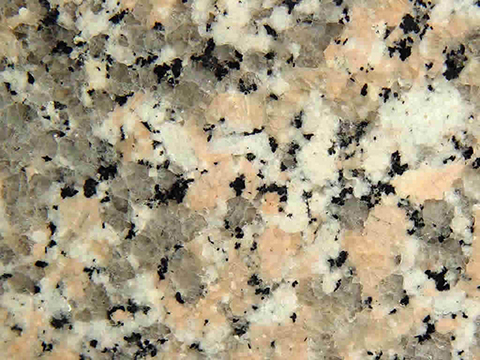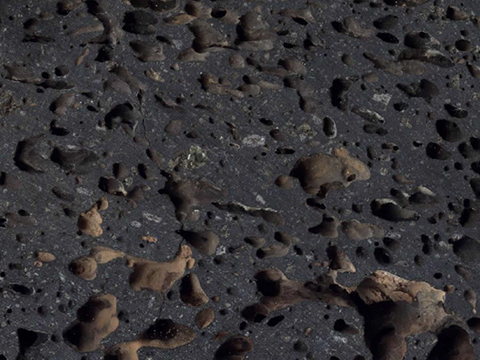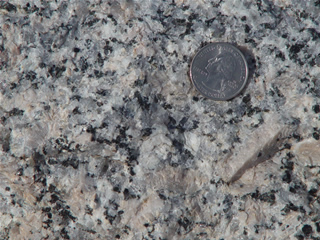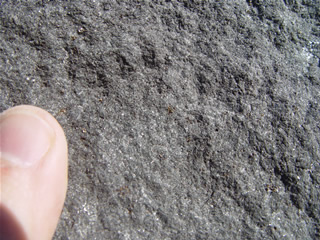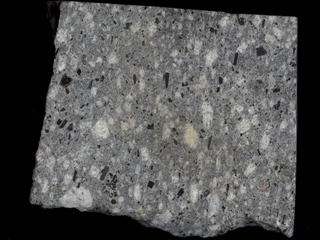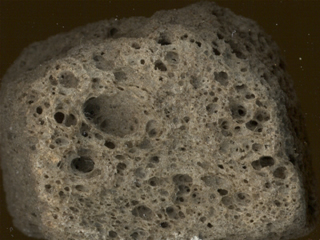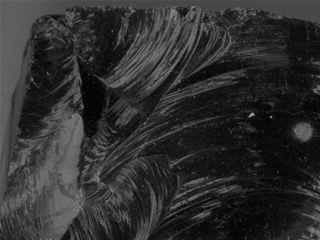Part A
Igneous Rock Composition & Texture
Igneous rocks are born of magma. Some magma may rise quickly and erupt on the surface, whereas others are destined to cool slowly and crystallize at depth. We typically can name igneous rocks and interpret their origins by observing both the type and arrangement of crystals in the rocks (i.e., composition and texture).
|
Figure 4-2. Composition and texture both define the different types of igneous rocks. A felsic, coarse-grained rock (left), and a mafic, vesicular rock (right). Both rocks were formed from cooling magma or lava. |
|
Compositions of Igneous Rocks
The identification procedure for igneous rocks involves describing the types and sizes of mineral crystals. Since plutonic rocks are generally coarse grained (they have large crystals visible to the naked eye), we have only to identify the minerals and their relative abundances in the rock. In volcanic rocks, the individual mineral crystals are commonly too small to identify, so the mineralogy (and thus, composition) is inferred from the color of the rock (although color is not always representative of composition). Chemical analysis and the determination of the abundances of certain elements (like Si, Fe, Mg, etc.) can be extremely helpful, not only in classifying these rocks, but in describing the nature and origin of these rocks. The main igneous compositions are listed below, and include felsic, intermediate, mafic, and ultramafic (also see Figures 4-3 and 4-4). Be sure to pass your cursor over the rock pick icons to see rock sample imagery.
> Generally light-colored; <15% dark-colored minerals.
> Mineralogy - Light-colored minerals include quartz (gray to clear), alkali feldspar (peach-colored to pale red), and plagioclase feldspar (white to gray), whereas the dark-colored minerals are mostly biotite (black flakes).
> Geochemistry - High SiO2 (>63 wt%), Al2O3, Na2O, K2O, etc.; low MgO, FeO, and CaO.
> Typically forms from melting continental crust.
> Forms high viscosity lava ("thick & sticky").
> Crystallizes at low temperatures (650-700ºC).
> Plutonic rock examples: granite, granodiorite, tonalite, syenite, quartz monzonite, alkali feldspar granite.
> Volcanic rock examples: rhyolite, dacite.
> Typically gray in color if fine-grained or light and dark ("salt and pepper") if coarse-grained; 15-40% dark-colored minerals.
> Mineralogy - Light-colored minerals include plagioclase feldspar with lesser quartz, whereas the dark-colored minerals are mostly hornblende (black masses or needles) and biotite (black flakes).
> Geochemistry - Moderate SiO2 (52-63 wt%).
> Commonly forms from hydrous (water-rich) crustal melting, magma mixing, etc.
> Typically involved in explosive, pyroclastic eruptions.
> Plutonic rock examples - diorite, quartz diorite.
> Volcanic rock examples - andesite, basaltic andesite.
> Generally dark in color; 40-90% dark-colored minerals.
> Mineralogy - Dark-colored minerals mostly include pyroxene (dark green to black) and olivine (green), whereas the light-colored minerals are mostly plagioclase feldspar (white to gray).
> Geochemistry - Low SiO2 (45-52 wt%), Al2O3, Na2O, K2O, etc., and high MgO, FeO, and CaO.
> Typically forms from melting ultramafic mantle.
> Forms low viscosity lava (thin & fluid).
> Crystallizes at relatively high temperatures (1000-1200ºC).
> Typically involved in passive, lava-rich eruptions.
> Plutonic rock examples - gabbro, diabase (dolerite).
> Volcanic rock examples - basalt.
> Very dark in color (black to green); >90% dark-colored minerals.
> Mineralogy - Dark-colored minerals almost exclusively pyroxene (dark green to black) and olivine (green).
> Geochemistry - Very low SiO2 (<45 wt%) and very high MgO, FeO, and CaO.
> Plutonic rock examples - peridotite, pyroxenite.
> Volcanic rock examples - komatiite.
|
|
|
Figure 4-3. Compositions of plutonic rocks include felsic (light-colored; <15% dark minerals), intermediate (15-40% dark minerals), mafic (dark-colored; 40-90% dark minerals), and ultramafic (>90% dark minerals where the green Fe- and Mg-rich mineral olivine counts as a "dark" mineral). |
|
|
|
Figure 4-4. Compositions of volcanic rocks, like their plutonic relatives, including felsic (light-colored), intermediate, and mafic (dark-colored). |
Questions A01 through A04 involve identification of igneous compositions like those shown in Figure 4-4.
![]()
![]()
![]()
![]()
Textures of Igneous Rocks
The texture of an igneous rock reflects its volcanic (extrusive) or plutonic (intrusive) origin and refers to the size, shape, and orientation of the crystals, or some other visible feature in the rock (see Figure 4-5). The texture of an igneous rock reflects its volcanic (extrusive) or plutonic (intrusive) origin. In general, cooling rate and/or depth of crystallization can be inferred from the size and arrangement of mineral crystals (texture) in a rock.
In plutonic rocks, slow cooling and crystallization beneath the Earth's surface yields only a handful of textures, all composed of mineral crystals large enough to see without a microscope. Plutonic rocks mostly have medium-grained (1-5 mm) to coarse-grained (5 mm to 2 cm) textures or larger. Alternatively, porphyritic textures are composed of crystals of more than one size, with larger crystals (phenocrysts) surrounded by smaller crystals (collectively referred to as groundmass).
Volcanic rocks have several different types of textures that result from a magma's cooling rate, eruption style, and/or gas content. Fine-grained textures (crystals <1 mm) result from rapid cooling. Glassy textures are formed so quickly that few, if any, crystals grow at all. Vesicular textures record the presence of gas in the lava, and pyroclastic textures represent explosive eruptions where the lava has been blown into fragments.
|
Figure 4-5. Igneous rocks with different textures (clockwise from upper left): coarse-grained (granite), fine-grained (basalt), porphyritic (andesite), glassy (obsidian), pyroclastic (tuff), and vesicular (pumice). |
||
> An equigranular texture (crystals have relatively the same size) where the majority of the crystals can be seen without a microscope (phaneritic means "to see").
> Average crystals are 5 mm to 2 cm in diameter. Medium-grained textures have crystals from 1 mm to 5 mm in diameter.
> Forms as magma cools slowly at depth.
> Plutonic rock examples - Granite, diorite, gabbro, pyroxenite, and peridotite are rocks that commonly have coarse-grained textures.
> An inequigranular texture with a mixture of larger crystals (phenocrysts) surrounded by smaller crystals (groundmass).
> In plutonic rocks, porphyritic-phaneritic textures include phenocrysts (larger crystals) and relatively large groundmass crystals that can be identified without a microscope (phaneritic).
> In volcanic rocks, porphyritic-aphanitic textures include a mixture phenocrysts surrounded by much smaller groundmass crystals. The abundance of phenocrysts can vary, but is typically <25% of the rock. Groundmass crystals are typically <1 mm in diameter and hard to see without magnification (aphanitic).
> Forms as magma crystallizes with at least two rates of cooling: one slower and at depth (forming the phenocrysts), the other faster and on/near the surface (forming the groundmass).
> The word porphyritic can be used as a modifier in the rock name (for example, basalt with olivine phenocrysts is termed porphyritic basalt).
> A porphyritic rock with abundant, large phenocrysts may be referred to as porphyry (e.g., feldspar porphyry).
> Plutonic rock examples - porphyritic granite.
> Volcanic rock examples - porphyritic basalt, porphyritic andesite, porphyritic rhyolite, rhyolite porphyry.
> Mostly crystals <1 mm in diameter (hard to see without magnification). Larger crystals (phenocrysts) may be present, but are minor in abundance.
> Form as lava cools and crystallizes rapidly on the Earth's surface.
> Volcanic rock examples - basalt, basaltic andesite, andesite, dacite, rhyolite.
> Crystals are few or absent.
> Some surfaces display conchoidal fracture that resemble concentric ripples.
> Forms as magma cools extremely fast, so there is no time for crystals to form.
> Volcanic glass alters (changes color, cracks, etc.) over time.
> Volcanic rock examples - volcanic glass, obsidian.
> A significant (>5%) amount of void spaces (vesicles), which may be open or filled with secondary minerals.
> Vesicles form as a gas-rich magma erupts and cools so quickly that the lava solidifies around the gas bubbles.
> Volcanic rock examples - scoria, pumice.
> Composed of fragments of various types (glass, crystals, or rock) and sizes ranging from very small (ash) to large (cinder, bombs,and blocks and bombs (>64 mm in diameter).
> Form during explosive volcanic eruptions.
> Volcanic rock examples - ash tuff, lapilli tuff, pyroclastic breccia.
Questions A05 through A09 involve identification of igneous textures like those shown in Figure 4-5.
![]()
![]()
![]()
![]()
![]()
